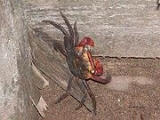
Sesarmidae
Encyclopedia
Sesarmidae is a family
of crab
s, previously included in the Grapsidae
by many authors. Several species, namely in Geosesarma
, Metopaulias
and Sesarma
, are true terrestrial crabs. They do not need to return to the sea even for breeding.
The genera
Chiromantes, Parasesarma, Pseudosesarma and Sesarmops are apparently not monophyletic. Scandarma may be a junior synonym of some other genus.
Family (biology)
In biological classification, family is* a taxonomic rank. Other well-known ranks are life, domain, kingdom, phylum, class, order, genus, and species, with family fitting between order and genus. As for the other well-known ranks, there is the option of an immediately lower rank, indicated by the...
of crab
Crab
True crabs are decapod crustaceans of the infraorder Brachyura, which typically have a very short projecting "tail" , or where the reduced abdomen is entirely hidden under the thorax...
s, previously included in the Grapsidae
Grapsidae
Grapsidae is a family of crabs known variously as marsh crabs, shore crabs or talon crabs. It is not confirmed that the family forms a monophyletic group and some taxa may belong in other families...
by many authors. Several species, namely in Geosesarma
Geosesarma
Geosesarma is genus of terrestrial crabs. They live and reproduce on land with the larval stages inside the egg. Some species such as Geosesarma nemesis are insectivorous and are beneficial to humans. Some species are kept as pets. They were once considered part of the Grapsidae family but were...
, Metopaulias
Metopaulias
Metopaulias is a monotypic genus of fully terrestrial land crabs which do not require to go back to the sea to spawn. Metopaulias depressus is a reddish-brown crab about wide which lives in the pools of water which form in the leaves of bromeliads in Jamaica...
and Sesarma
Sesarma
Sesarma is a genus of terrestrial crabs. Many species within this genus live in mangroves. They have evolved to be fully terrestrial, which means they do not have to return to the sea even to spawn...
, are true terrestrial crabs. They do not need to return to the sea even for breeding.
Genera
The family contains the following genera:- AratusAratus pisoniiAratus pisonii, commonly known as the mangrove tree crab, is a species of crab which lives in mangrove trees in tropical and subtropical parts of the Americas, from Florida to Brazil on the Atlantic coast, and from Nicaragua to Peru on the Pacific coast. It feeds mostly on the leaves of the...
- Armases
- Bresedium
- Chiromantes
- Clistocoeloma
- Episesarma
- GeosesarmaGeosesarmaGeosesarma is genus of terrestrial crabs. They live and reproduce on land with the larval stages inside the egg. Some species such as Geosesarma nemesis are insectivorous and are beneficial to humans. Some species are kept as pets. They were once considered part of the Grapsidae family but were...
- Haberma
- KarstarmaKarstarmaKarstarma is a genus of karst-dwelling crabs formerly included in Sesarmoides.-Description:Karstarma is distinguished from the closely related Sesarmoides by the lack of a stridulatory structure on the cheliped which is present in the latter genus.-Ecology & biogeography:All species in the genus...
- Labuanium
- Metagrapsus
- Metasesarma
- MetopauliasMetopauliasMetopaulias is a monotypic genus of fully terrestrial land crabs which do not require to go back to the sea to spawn. Metopaulias depressus is a reddish-brown crab about wide which lives in the pools of water which form in the leaves of bromeliads in Jamaica...
- Muradium
- Namlacium
- Nanosesarma
- Neosarmatium
- Neosesarma
- Parasesarma
- PerisesarmaPerisesarmaPerisesarma is a genus of mangrove crabs in the family Sesarmidae predominantly found in the Indo-Pacific. There are 23 species as of late 2006 with two from west Africa: P. kammermani & P. alberti Rathbun, 1921. They are typically small semi-terrestrial crabs found on the forest floor at low tide...
- Pseudosesarma
- Sarmatium
- Scandarma
- Selatium
- SesarmaSesarmaSesarma is a genus of terrestrial crabs. Many species within this genus live in mangroves. They have evolved to be fully terrestrial, which means they do not have to return to the sea even to spawn...
- Sesarmoides
- Sesarmops
- Stelgistra
- Tiomanum
The genera
Genera
Genera is a commercial operating system and development environment for Lisp machines developed by Symbolics. It is essentially a fork of an earlier operating system originating on the MIT AI Lab's Lisp machines which Symbolics had used in common with LMI and Texas Instruments...
Chiromantes, Parasesarma, Pseudosesarma and Sesarmops are apparently not monophyletic. Scandarma may be a junior synonym of some other genus.
Selected species
- Chiromantes dehaaniChiromantes dehaaniChiromantes dehaani is a mudflat crab of the Sesarmidae family , which is endemic to East Asia. It typically lives in mangrove swamps and is known under the common name kurobenkeigani in Japan. C. dehaani has an uneven carapace, which is divided into four frontal lobes...
— kurobenkeigani (Japanese) - Chiromantes haematocheirChiromantes haematocheirChiromantes haematocheir is a mudflat crab of the family Sesarmidae , which is endemic to East Asia. It is known under the common names red-clawed crab or akategani and the Latin names Grapsus heamotocheir and Sesarma heamotocheir...
— red-clawed crab; akategani (Japanese) - Parasesarma erythrodactylaParasesarma erythrodactylaParasesarma erythrodactyla, also known as the red-handed shore crab, is a burrowing crab inhabiting mangrove forests in Australia and Southeast Asia. It is immediately identifiable by its bright red chelipeds and green/brown carapace....
— red-handed shore crab - Parasesarma pictumParasesarma pictumParasesarma pictum is a mudflat crab, belonging to the Sesarmidae family , which is endemic to East Asia. This crab typically inhabits mangrove swamps, preferring the upper intertidal region of estuaries, and living in small crevices and abandoned holes made by other species. It eats leaf litter...
— kakubenkeigani (Japanese)

